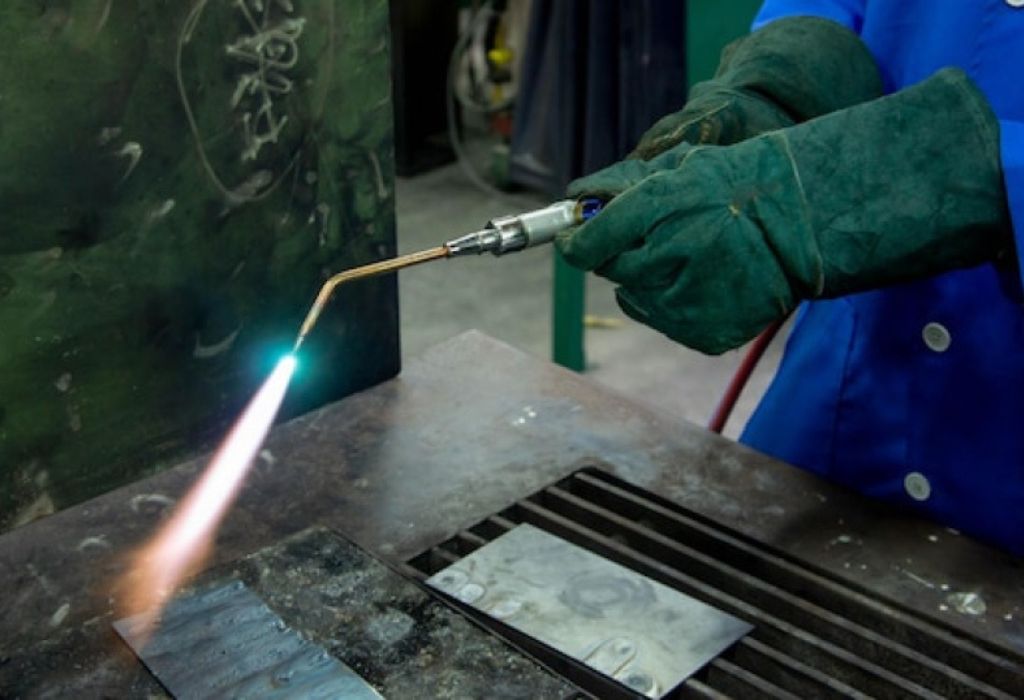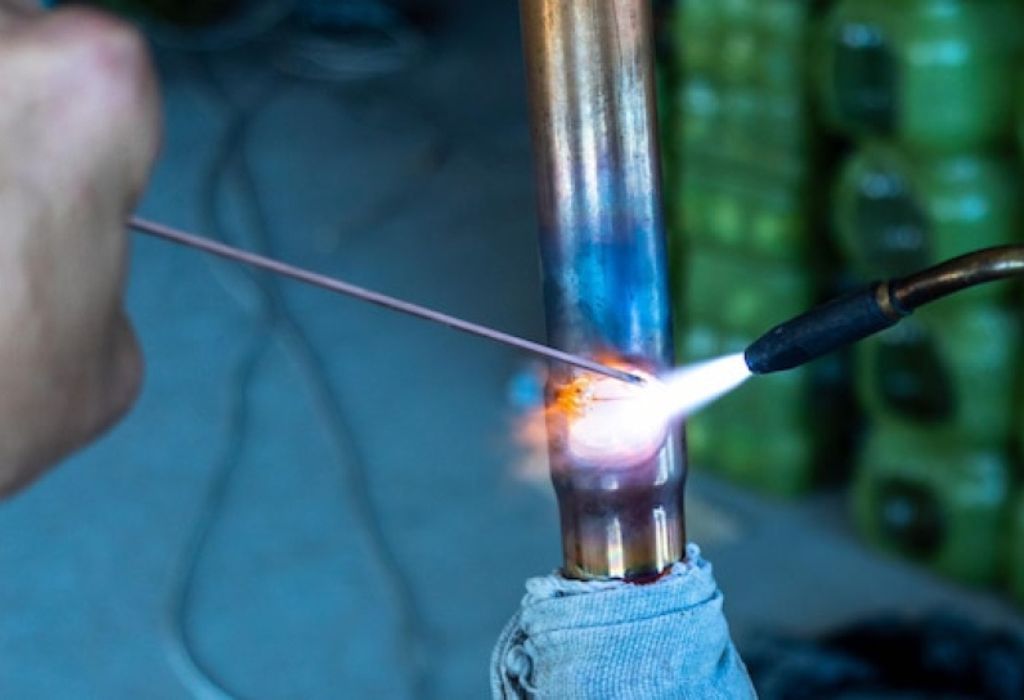A cracked cast iron manifold sits cold on the bench, its jagged edge showing the story of heat, stress, and time.
You grab your TIG torch, but the real challenge isn’t lighting an arc — it’s keeping that casting from shattering again.
Cast iron, famous for its strength and rigidity, hides a weakness that frustrates welders worldwide.
Its high carbon content makes it brittle under sudden temperature change, turning repairs into a balancing act of heat and patience.
When welders ask how to TIG weld cast iron, what they’re really asking is how to control that balance.
TIG welding gives unmatched precision and clean control, but it also demands perfect preparation.
The wrong filler, rushed preheat, or uneven cooling can ruin hours of careful work.
Studies show that over 60% of failed cast iron welds occur due to poor temperature control (Miller Welds).
Unlike mild steel, cast iron isn’t forgiving.It can form hard, crack-prone structures like martensite if overheated or cooled too fast.
That’s why professionals rely on slow preheating between 260°C and 370°C, followed by gradual cooling wrapped in insulation or sand (Lincoln Electric).
This guide breaks the mystery down into science and steps.You’ll learn how to identify different types of cast iron, choose nickel or bronze filler rods, and control every degree of temperature from start to finish.
Whether you’re repairing an engine block, vise, or vintage tool, this guide will show how to TIG weld cast iron safely, efficiently, and with lasting strength.
What Makes Cast Iron Hard to Weld

Cast iron’s toughness is deceptive.
Its high carbon content — often 2 % to 4 % — gives it compressive strength but extreme brittleness.
When heat enters unevenly, that carbon shifts and creates tiny hard spots that fracture under stress.
The welding zone transforms chemically during heating.
Carbon combines with iron to form cementite (Fe₃C), a brittle compound that reduces flexibility.
If cooled too fast, it hardens into martensite, a glass-like phase that cracks easily.
Unlike mild steel, cast iron won’t bend to relieve stress.
Instead, it snaps.
That’s why temperature control and filler selection are the foundation of success when TIG welding cast iron.
Different iron types react differently to TIG welding.
Gray iron is weldable with care.
Ductile (nodular) iron can be joined if slowly heated and cooled.
White iron, however, is too hard and unstable — welding usually destroys it.
Why does cast iron crack when welded?
Because high carbon and low ductility cause internal stress when temperatures change too quickly.
Can you TIG weld all kinds of cast iron?
No. Gray and ductile iron are weldable; white iron should be replaced.
What’s the hardest part of welding cast iron?
Maintaining even heat distribution from start to finish.
Why preheat cast iron before welding?
To reduce thermal shock and prevent hard, brittle structures from forming.
Is TIG the best process for cast iron?
It’s ideal for thin or precision parts where control matters more than speed.
Gear Checklist for TIG on Cast Iron
Before striking an arc, preparation determines everything.
Having the right gear ensures consistent heat, penetration, and metal flow.
1. TIG Welder with Precise Control
A high-frequency TIG machine with adjustable amperage helps balance heat and avoid overheating the base metal.
2. Filler Rod Selection
The best choices are ENi-CI (Nickel 99) and ENiFe-CI (Nickel-Iron) rods.
Nickel 99 produces soft, machinable welds; Nickel-Iron rods create stronger joints but are harder to machine.
Some professionals also use silicon bronze (ERCuSi-A) for TIG brazing at lower temperatures.
3. Tungsten Electrode
Use 2 % thoriated or lanthanated tungsten (3/32″) for stability and steady arc control.
4. Shielding Gas
Pure argon at 15–20 CFH flow rate protects the weld from oxidation.
5. Preheating Equipment
A propane torch, induction heater, or oven keeps the casting evenly warm before and during welding.
6. Cooling Setup
Use dry sand, vermiculite, or a heavy welding blanket to slow the cooling rate after the weld.
What filler rod should be used for TIG welding cast iron?
Use Nickel 99 for machinability or Nickel-Iron for strength.
Can you TIG weld cast iron without preheating?
Not recommended — it increases cracking risk drastically.
Why use argon gas?
It provides a stable arc and protects the molten puddle from oxygen.
Is silicon bronze good for cast iron?
Yes, for TIG brazing repairs that don’t require fusion.
What tungsten size works best?
3/32″ thoriated or lanthanated tungsten offers a steady, focused arc.
Preparation Before Welding
Preparation defines how clean and strong your weld will be.
Rushing this stage causes cracks even before the weld solidifies.
Start by cleaning the casting thoroughly with a grinder or wire brush.
Remove paint, oil, carbon, and rust — impurities destroy the weld pool and gas coverage.
Use acetone or brake cleaner to degrease the area.
Next, inspect for hidden fractures.
Tiny cracks can spread when heated.
Drill small stop-holes at crack ends to prevent further propagation.
Finally, preheat the part evenly.
Use a temperature stick or infrared thermometer to monitor it.
Maintain between 260 °C and 370 °C (500–700 °F) for gray iron, slightly higher for ductile.
Why clean cast iron before welding?
Oil and carbon contamination weaken the weld and cause porosity.
How can you spot hidden cracks?
Use dye penetrant spray or magnifying inspection under light.
Why drill holes at the crack ends?
They relieve stress and keep the crack from spreading.
How long should preheating last?
At least 30 minutes for small parts; up to 2 hours for heavy castings.
Can you skip cleaning?
No — TIG welding requires absolute cleanliness for arc stability.
TIG Welding Process Step by Step
Now comes the heart of the process — melting and fusing cast iron under perfect control.
Step 1: Set the Amperage
Use 40–100 amps depending on thickness.
Low heat prevents burn-through, while too little heat leads to poor fusion.
Step 2: Control the Arc Length
Keep the tungsten about 1/8 inch from the puddle.
A tight arc concentrates heat and limits carbon migration.
Step 3: Apply Short Weld Beads
Cast iron prefers short bursts.
Weld 1 inch or less, then peen the bead lightly with a hammer to relieve stress.
Step 4: Pause and Maintain Heat
Alternate welding sides if possible.
Keep the overall casting at steady temperature by reheating between passes.
Step 5: Post-Weld Cooling
Immediately after welding, cover the part with dry sand or insulation to cool slowly over several hours.
This gradual cooling prevents cracking and preserves ductility.
Should you weld continuously?
No. Short beads and cooling pauses prevent stress buildup.
Why peen after welding?
It stretches the metal slightly, countering shrinkage stress.
How slow should the part cool?
It should take several hours to return to room temperature.
Can you use a fan to cool it faster?
Never — forced cooling will cause instant cracking.
Why alternate sides?
It balances expansion and keeps distortion low.
Post-Weld Treatment and Inspection
After cooling, proper finishing ensures the repair lasts for years.
Start by gently brushing away flux or oxidation.
Use a light grinder only if needed — avoid overheating the weld area again.
If the weld must be machined, Nickel 99 filler offers the easiest cutting.
For strength-critical components, Nickel-Iron rods hold up better under stress.
Next, check for surface cracks.
Dye penetrant testing or ultrasonic inspection detects flaws before they grow.
Finally, store the repaired casting in a dry, stable environment.
Humidity and vibration can reintroduce stress in freshly welded metal.
Do TIG welds on cast iron need machining?
Only when fitment or sealing surfaces are critical.
How do you check weld quality?
Use dye penetrant or ultrasonic testing for cracks.
What happens if the weld cools too fast?
It hardens and cracks due to internal stress.
Can you heat-treat cast iron after welding?
Yes, slow reheating and soaking at 600 °C (1100 °F) can relieve stress in heavy parts.
How to protect the weld from corrosion?
Apply a thin coat of oil or paint after cooling.
Common Mistakes to Avoid

Even experienced welders make small errors that ruin cast iron joints.
Avoid these pitfalls every time you set up.
- Skipping Preheat: Thermal shock cracks even small castings.
- Using Steel Filler: Steel expands differently and promotes cracking.
- Overheating the Base Metal: Exceeds carbon solubility, forming brittle phases.
- Cooling Too Fast: Causes micro-fractures you can’t see immediately.
- Ignoring Cleanliness: Oils and carbon contaminate the weld pool.
Consistent temperature and clean surfaces are the real secrets behind successful TIG welds on cast iron.
Why not use steel filler?
It expands differently, creating stress lines that crack the casting.
What’s the safest cooling method?
Bury the part in dry sand or wrap it with insulation.
Why do some welds fail after a day?
Hidden stress fractures appear as the weld fully contracts.
Can you re-weld a cracked repair?
Yes, but you must grind it out, re-preheat, and repeat the process slowly.
Is TIG brazing easier?
Yes — it joins at lower temperatures, reducing the risk of cracking.
Conclusion
TIG welding cast iron is a test of patience, not just skill.
It demands temperature control, cleanliness, and respect for metallurgy.
When done right, a repaired casting regains both strength and life.
By understanding how carbon behaves under heat, choosing the right filler, and mastering preheat and cooling, any welder can restore iron parts once thought impossible to save.
So next time a cracked engine block or vise lands on your bench, you’ll know exactly how to TIG weld cast iron step by step — and do it the right way.

I’m Darrell Julian, the founder, lead writer, and hands-on welding enthusiast behind ArcWeldingPro.com. With more than 15 years of real-world welding experience, I created this platform to share what I’ve learned in the field, in the shop, and in the heat of the arc.


